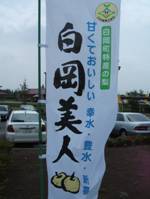@
@
|
15 The Beauty of Shiraoka |
@
| gHosuiiL jh ,gKosuiiK jh , gThe 20th centuryiQO¢Ijh c Can you guess what these are? If I add one or two more examples, you will know the answer. gChojuroh(·\Y) and@gLa Franceh. Yes! They are all the names of pears. |
 |
@
|
|
Then, do you know which town has produced the most pears every year in Saitama? It is Shiraoka-Town. They get more than 3,000 tons of pears every year in Shiraoka. But why is Shiraoka famous for pears? Who started growing pears? |
@
| The people in Shiraoka started growing pears in the
Meiji period. In 1884i¾¡17N), a man studied how to grow pears.
His name was Igarashi Hachigoro .(Ü\ªÜY)
In Gunma, he learned how to grow them well and taught it to his
relatives. That was the
start.
In 1910i¾¡43Nj, there was a big flood around Shiraoka.
Other crops were terribly damaged by the flood. But pears were
safe because they were grown on the
shelves. (Please look at the picture on the right.)
Can
you imagine how they gathered pears at that time?
They used boats!
Do you know how to choose good pears when you go to a grocery store? Ifll teach you how to tell good pears from bad. Good pears are light-brown. If the gbellybuttonh of the pear is black, that means it is too ripe or it was eaten by a worm. |
|
|
|
@
|
|
You can enjoy fresh pears in the late summer.
Because they are so sweet and fresh, the pears are called gShiraoka-Bijinh(The
beauty of Shiraoka). But if
you canft visit Shiraoka during the best season of pears, you donft
have to be disappointed. Pears
are made into many kinds of sweets such as jelly.
I am sure you will like it because its name is gMonku-nashi
jellyh. Now, you canft
complain, can you? (293ê) |
|
ªàñ³ü¡µ¢I |
@
|
pear produce(d)@¶Y·éA¶Ýo·@ ton(s) id³ÌPÊjg @relative(s) eÊ flood^ @@crop(s) _ì¨@ were terribly damaged å«ÈíQðó¯½ on the shelves I©¯µÄiIðgÁÄÍ|·é±Æj grocery store@ªS® how to tell good pears from bad Ǣ̩ª¯û@@light-brown @FÌ bellybutton¨Ö»@@ripenêÄ¢é worm@@be disappointed @ªÁ©è·é@ jelly[[@@complain ¶å𾤠|
@
@
@
@
![]()
@
@
@
|
éÊÌKChubNð©ÈªçNX[gÌmiHitoshijÆbµÄ¢Ü·B |
||
| Greg: | Hey, Hitoshi. I want to visit this town, Shiraoaka. How can I get there? | |
| Hitoshi: | I think I can go with you. Itfs not so far from here. But why do you want to visit it? | |
| Greg: | Wellc. Do you have a girlfriend? | |
| Hitoshi: | No. But why? | |
| Greg: | I have wanted a Japanese girlfriend since I came to |
|
| Then, I found this comment in my guidebook. It says, gShiraoka is famous for Shiraoka-Bijin.h | ||
| gBijinh means ga beautiful womanh in Japanese, right? | 
|
|
| I guess there are so many beautiful girls in Shiraoka. | ||
| Will you be free next Sunday? Letfs go together! | ||
| Hitoshi: | Ha-ha-ha! Ifm afraid you misunderstood. | |
| Greg: | What do you mean? | |
| Hitoshi: | gThe beauties in Shiraokah are sweet and fresh. | |
| But they have round and light-brown faces. | ||
| Greg: | ... You mean they are not so pretty? | |
| Hitoshi: | I mean they are not human beings! | |
| Greg: | Oh, no! What are gShiraoka-Bijinh then? |
|
| Hitoshi: | The pears in Shiraoka are called gShiraoka-Bijinh because they are sweet and fresh. | |
| Greg: | Pears? | |
| Hitoshi: | Come on, Greg! Donft be disappointed. | |
| Shiraoka-Bijin is really delicious. | ||
| We can enjoy picking pears in Shiraoka. Itfs really fun. | ||
| We can also buy cakes or jam made from pears. | ||
| They are very delicious too. | ||
| Greg: | Oh! Do you remember? Mayumi, our classmate, |  |
| once said that she loved cakes. Ifm sure she will like | ||
| the cakes of Shiraoka-Bijin! I want to buy one for her. | ||
| Do you think she will be happy with my present? | ||
| Mayumi is so lovely. I want her to be my girlfriend! | ||
| Hitoshi: | c You never learn, do you? | |
@
|
guidebookKChubN misunderstood misunderstandiëð·éjÌß` human beingslÔ@@picking pears @ëè@@you never learn @±èÈ¢z¾È |
@
@
@
@
@
@